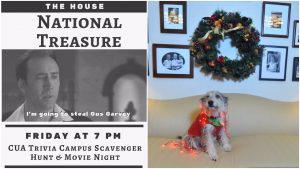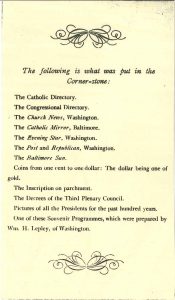
There are many ways to connect the present with the past. One of the easiest is through physical objects, such as, say, informing students on the history of the physical space of their university campus. The Archives worked with Campus Ministry this past November on an event which had students playing trivia, doing a campus scavenger hunt, and watching National Treasure, a heist film involving a search for a treasure hidden by the American Founding Fathers. The event, inspired by the film and thus dubbed “National Treasure” itself, had students exploring the Catholic University campus for prizes while learning about the layers of history embedded on the campus itself.

Indeed, the National Treasure reference is not really that far off the mark. Take the first structure built in 1803 on what is now the University campus, Sidney. Sidney, after the political theorist Algernon Sidney, was built and occupied by Margaret Bayard Smith and her husband, Samuel Harrison Smith, who was invited to move to the District of Columbia by then President Thomas Jefferson in order to publish the city’s first newspaper, The National Intelligencer, which he did. Jefferson, James and Dolley Madison, and other political luminaries visited Sidney back in the early days of Washington, D.C. Later, the house was sold to the Middleton family, and in 1887, to the founders of the Catholic University.

The scavenger hunt/trivia night involved exploration of some of the earliest physical aspects of the campus, including two of CUA’s founders: Mary Gwendoline Caldwell’s eponymous Caldwell Hall and its cornerstone, laid in 1888, as well as the ginormous marble statue of Leo XIII that found itself in the foyer of McMahon Hall when it was constructed in 1895 and hasn’t moved since.
More recently built structures are quickly acquiring some local historical significance, too. The Great Rooms of the Pryzbyla Center hosted Pope Benedict XVI during his visit to the United States in 2008. And the lower level of the Pryz features a painting of a CUA Cardinal done by the actor Jon Voight while he was a student here in the late 1950s—the painting was originally done on the floor of the gymnasium, which was housed in what is today the Crough Center for Architectural Studies.

And what happened to Sidney?
This link explains more, see http://cuexhibits.wrlc.org/exhibits/show/vanished-buildings/buildings/st–thomas-hall